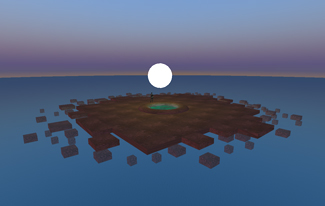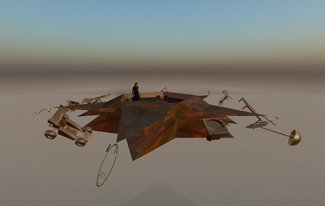Second Life -- "A libertarian paradise where there are no zoning laws"
Doug Anderson just completed a thesis in Second Life that earned him a masters of science in art education from the Massachusetts College of Art and Design ("MassArt"). He is an art teacher at Prospect Hill Academy, a charter school in Cambridge and Somerville, MA.
The title of the thesis was "Force Sun Midnight," displayed in a Second Life "sim" (a simulator with its own CPU in a server) and also in the Massachusetts College of Art and Design ("MassArt"), Arnheim Gallery -- complete with its own 3D goggles so the art leapt out at you from the wall.

The medium totally engages Anderson -- thus the reference to paradise. He explains: "Second Life's strength is in being a stage set for human interaction. I don't consider any of my work done until people show up. When you go there with a bunch of friends and start poking around, the artwork is complete. My work borrows a lot of basic structure from video games, especially open-ended games like Myst: The idea is that you are in an environment, you don't start with any clear objective, you have to explore a little bit, poke and probe a little bit to see what's going on. I leave a lot of cookies [not browser cookies, but little rewards for finding an interactive spot] or Easter eggs for people to reward careful exploration. You might click on something and find out that you can make a copy of it, or that it's animated, or that it responds to another object or makes a sound, for example. It might take a good 30 or 40 minutes to go through one of my environments and find all that's there -- or you might not find all that's there, so it bears repeated viewings."
When this editor visited one of Anderson's two exhibits, my avatar saw a plane about to crash into a street crossing with traffic stopped for a red light. My avatar, curious, flew up to see the plane more closely and it realized it could fly into the plane where the wing had broken off to see what was happening with the people inside. Fortunately, as my avatar was relieved to see, there were no people in the plane. But it felt uncomfortable being inside a plane about to crash.
How is such intricate and esthetically robust work possible in Second Life? Anderson notes that just in the past year, Second Life introduced a couple of innovations. First,
the ability to make objects that are irregular or 'organic.' "I can use any number of programs to make the object and then can import them as a texture into SL," Anderson comments. "Before that, if you wanted to make something like a tree, you had to use dozens or hundreds of objects that were never convincing. This technology came along in the middle of this work and so I had to master that technology." The second is
the addition of voice chat. "It was introduced last year very slowly at first but there was a tipping point and now people can talk instead of typing," says Anderson. Voice was important so that he could lead people through the show and narrate as he went from place to place.

Even though Anderson is an experienced SL builder (both "architect and contractor"), he still needed advice about how to create an art exhibit in SL. As is always the case, an experienced SL artist came forward, someone whose avatar is Tayzia Abattoir. Tayzia is the curator of the oldest art museum in SL. Also assisting Anderson was the New Media Consortium, in particular Larry Pixel [Larry Johnson in rl], head of the NMC. "He manages a huge conglomerate of sims," says Anderson. "The MIT sim is under his aegis. [NMC] just donated a quarter of a million dollars to develop an open source [environment] in SL."
According to the NMC site, on February 26, 2008, "the New Media Consortium (NMC) announced a $250,000 two-year collaboration with Sun Microsystems to launch the Open Virtual Worlds Project, an effort that is aimed at making it easier to learn, work, and exchange ideas in virtual space. The project will develop a range of standards-based, portable open-source educational spaces, content, and objects, and use them to extend Sun Microsystems's open source Project Darkstar and Project Wonderland virtual world platforms."
But isn't this art ephemeral? We asked Anderson. "Very much so, and that gives it its value for me," he said. "It's kind of poignant knowing I put these things up, people can see them awhile, and then they go away. That's very much in the spirit of second life. People come into SL, they look at it, they see a landscape; the metaphor they take away with them is that this is a geography, things are next to each other. But because you can teleport from any point to any point, geography is really meaningless; it is more helpful to think of it as a movie back lot -- as you know, SL is littered with these abandoned or mis-used sets. I would rather have my stuff come down and not just hang out there forever. I do save the key components to my work and could always resurrect it. If I did, I'd want to make changes. If I took the time to set it up, I'd want to do it differently."
We asked Anderson what would you say to college art teachers. "I would say, you want to look at SL as a place to teach sculpture and to teach design simply because it's very forgiving, you can make multiple variations, iterations of objects that you create, not limited by the size of your studio, and accessible from anywhere. If I was teaching a sculpture course or a design course at the college level, I probably would use SL as one of my platforms because of its flexibility, its lack of physical limitations."
He recommended that people visit Fairchange Village on Fairchange Island in SL to see an exhibit.
Even though Anderson's exhibit has "ephemerated" away, you can still find out more from him at his blog:
slowsculpture.livejournal.com/.
"Blackthorn Hare" is his avatar.
[Images courtesy Doug Anderson.]
About the Author
Trent Batson is the president and CEO of AAEEBL (http://www.aaeebl.org), serving on behalf of the global electronic portfolio community. He was a tenured English professor before moving to information technology administration in the mid-1980s. Batson has been among the leaders in the field of educational technology for 25 years, the last 10 as an electronic portfolio expert and leader. He has worked at 7 universities but is now full-time president and CEO of AAEEBL. Batson’s ePortfolio: http://trentbatsoneportfolio.wordpress.com/ E-mail: [email protected]

